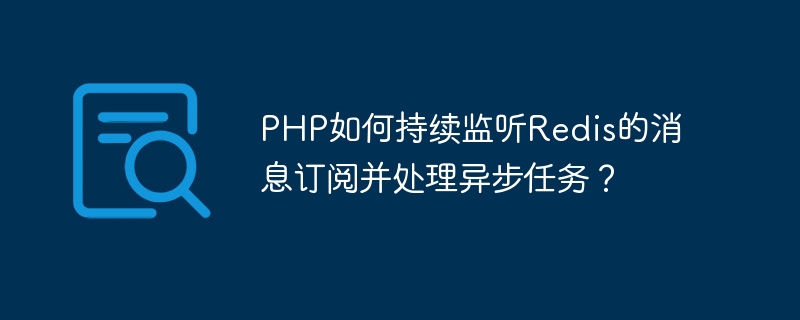Home >Backend Development >PHP Tutorial >How does PHP continue to listen to Redis message subscriptions and handle asynchronous tasks?
How does PHP continue to listen to Redis message subscriptions and handle asynchronous tasks?
- WBOYWBOYWBOYWBOYWBOYWBOYWBOYWBOYWBOYWBOYWBOYWBOYWBOriginal
- 2023-09-05 15:28:421026browse

How does PHP continue to listen to Redis message subscriptions and process asynchronous tasks?
In PHP development, we often face scenarios of processing asynchronous tasks. As a high-performance in-memory database, Redis provides a Pub/Sub mechanism that can be used to publish and subscribe to messages. This article will introduce how to use PHP to continuously listen to Redis message subscriptions, and demonstrate how to handle asynchronous tasks through code examples.
Understanding the Pub/Sub mechanism of Redis
Before we begin, we first need to understand the Pub/Sub mechanism of Redis. Pub/Sub is a mechanism used by Redis for message publishing and subscription, which can realize one-to-many message delivery. Among them, the sender of the message is called the publisher (Publisher), and the receiver of the message is called the subscriber (Subscriber).
The Pub/Sub mechanism of Redis mainly has the following key concepts:
- Channel (channel): Communication between message publishing and subscription is carried out through channels. A message can be published to one or more channels, and subscribers can choose to subscribe to the channels of interest.
- Subscription: Subscribers subscribe to one or more channels through the SUBSCRIBE command. Once the subscription is successful, they can receive messages from the channel.
- Publishing (publishing): The publisher publishes the message to the specified channel through the PUBLISH command, and all subscribers who subscribe to the channel will receive the message.
- Unsubscription: Subscribers can unsubscribe from one or more channels through the UNSUBSCRIBE command. Once the unsubscription is successful, they will no longer receive messages from the channel.
PHP implements Redis message subscription and asynchronous task processing
Next, we will use PHP to implement Redis message subscription and process asynchronous task processing.
1. Install the Redis extension
First, we need to install the Redis extension. You can use the PECL command to install the Redis extension. The command is as follows:
$ pecl install redis
After the installation is complete, add the following configuration in the php.ini file:
extension=redis.so
2. Subscribe to Redis messages
Use PHP code to connect to Redis and subscribe to messages. The sample code is as follows:
<?php
$redis = new Redis();
$redis->connect('127.0.0.1', 6379);
$redis->subscribe(['channel1', 'channel2'], function ($redis, $channel, $message) {
echo "Received message from channel: {$channel}, message: {$message}
";
});
?>In the above code, we first connect to the Redis server through the $redis->connect() method. Then, use the $redis->subscribe() method to subscribe to one or more channels and receive messages through the callback function.
3. Publish Redis messages
Use PHP code to publish messages to the Redis channel. The sample code is as follows:
<?php
$redis = new Redis();
$redis->connect('127.0.0.1', 6379);
$message = 'Hello, Redis!';
$redis->publish('channel1', $message);
?>In the above code, we first pass $redis- >connect()Method to connect to the Redis server. Then, use the $redis->publish() method to publish the message to the specified channel.
4. Processing asynchronous tasks
During the message subscription process, we can process the received messages according to actual needs. Here we take processing asynchronous tasks as an example. The sample code is as follows:
<?php
$redis = new Redis();
$redis->connect('127.0.0.1', 6379);
$redis->subscribe(['task_queue'], function ($redis, $channel, $message) {
echo "Received message from channel: {$channel}, message: {$message}
";
// 处理异步任务
handleAsyncTask($message);
});
function handleAsyncTask($message) {
// 模拟处理耗时任务
sleep(5);
// 处理完成后执行其他逻辑
echo "Async task handled: {$message}
";
}
?>In the above code, we subscribe to the channel named task_queue and call handleAsyncTask( after receiving the message ) method handles asynchronous tasks. In the handleAsyncTask() method, we simulate processing a time-consuming task and execute other logic after the task is completed.
Summary
This article introduces how to use PHP to continuously listen to Redis message subscriptions, and demonstrates how to handle asynchronous tasks through code examples. By using the Pub/Sub mechanism of Redis, we can effectively implement message publishing and subscription, improving application concurrency and response speed. I hope this article can be helpful to everyone in the process of handling asynchronous tasks.
The above is the detailed content of How does PHP continue to listen to Redis message subscriptions and handle asynchronous tasks?. For more information, please follow other related articles on the PHP Chinese website!

